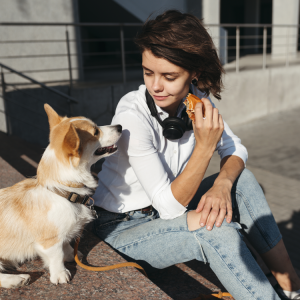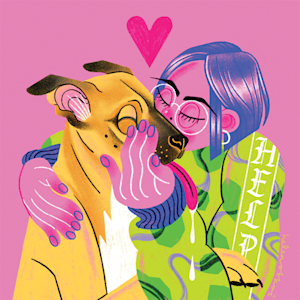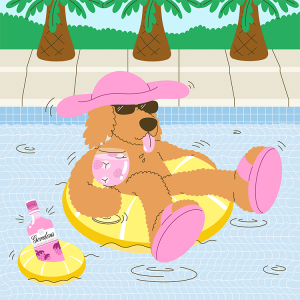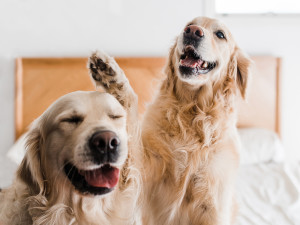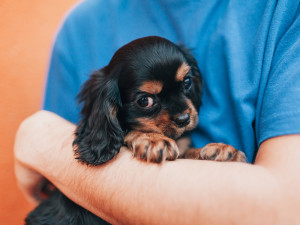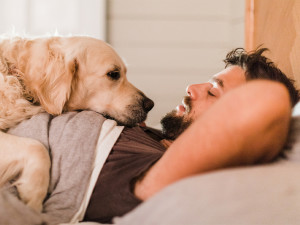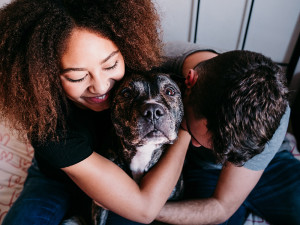Why Do We Have the Urge to Squeeze Our Adorable Pets?
There’s a scientific reason for this impulse.

Share Article
Every morning, I ask my dog the same questions: “Are you so cute?” “How are you so cute?” “Why are you so cute?” “Can you believe you are so cute?” She does not respond to me — a lady never tells — and I do what any loving pet parent would do: resist the urge to put her entire little head in my mouth. No, I don’t mean I literally want to do this. But something about her is really triggering a particular feeling.
There’s a word for it in the Philippines: “gigil.” opens in new tab In Indonesia, it’s referred to as “gemes” or “gemas.” Among the scientific community, this desire to squeeze, pinch, and bite cute things without the desire to do any actual harm is called “cute aggression.”
Dr. Oriana Aragón, an assistant professor at the University of Cincinnati, coined the term in a 2015 paperopens in new tab, which looked at displays of both caretaking and aggression as a response to cute stimuli. “When people see cute entities, they experience strong positive emotion, and they have strong urges to nurture, protect, and interact with the cute being,” Dr. Aragón tells me.
Per her research, an estimated 50 to 60 percent of people respond to overwhelming positive feelings with a reaction that looks like aggression. (i.e., clenched fists, gritted teeth, pinching, wanting to put your dog’s head in your mouth, etc.). Rest assured that if you inexplicably want to squish your pet, you are not alone. Still, it begs the question: Why do we want to squeeze cute things?
How much do you spend on your pet per year?

First, let’s talk cuteness.
Though cuteness is ultimately in the eye of the pet holder, there are scientifically agreed upon traits associated with “cute” creatures. Dubbed the “baby schema” in the 1940s, physical features like big eyes, pudgy cheeks, small limbs, and a large head tend to be seen as cute. These attributes are more common among infants, hence the name “baby schema.”
However, as Dr. Aragón explains, cuteness is relative: “When we see a whale in the ocean that is a mini version of its full-grown mom, we see it as cute.” Cuteness can also be applied to inanimate objects: “Take for instance the VW Beetle with strongly rounded features. It is seen as very cute.”
Scientists dating back as far as Charles Darwin have theorized that cuteness may have an evolutionary benefit. Domestication syndromeopens in new tab, a theory attributed to Darwin, suggests species who have been domesticated have unique traits — such as floppier ears, shorter muzzles, and more juvenile behavior — in comparison to their wild counterparts. Comparatively, they are cuter.
As Dr. Aragón notes, humans want to pay attention to and take care of creatures we think are cute. Unlike their wild counterparts, domesticated animals depend on human care, and babies famously cannot take care of themselves. So, the cuter the creature (human, pet, or otherwise), the more likely it is to elicit caretaking behavior, which ultimately means receiving more resources to survive. Put simply, being cute helps keep them alive.
This is your brain on “cute.”
If you feel an impulse to caretake cute things, that isn’t all in your head, at least metaphorically speaking. Our brains respond positively to cuteness. One 2012 study on opens in new tab “Kawaii,”opens in new tab a Japanese word meaning “cute,” found that viewing cute images can help promote attentiveness and more careful behaviors. In this study, participants played the board game Operation, a notoriously frustrating game that relies on dexterity and hand-eye coordination.
After playing once, half the participants were shown pictures of puppies and kittens while the other was shown pictures of adult dogs and cats. When both groups played Operation a second time, the group shown pictures of puppies and kittens significantly improved their performance while the other group showed no notable change.
Another studyopens in new tab on the impact of cuteness on human behavior found that people are more likely to recycle when the recycling bin featured cute imagery. Research consistently shows that cuteness engages the “reward center” of our brain. Meaning, it feels good to interact with cute things.
If cute things make us feel good, what’s “cute aggression”?
Cute aggression is a type of dimorphous expression, which is when your outward action doesn’t seem to match your internal emotion. Think happy crying, laughing when you’re upset, or, in this case, wanting to squeeze something because you think it’s so cute. These sorts of behaviors tend to cluster. Meaning, if you’re the kind of person who cries at weddings, you likely also experience cute aggression.
In 2018, researchers at the University of California-Riverside conducted a studyopens in new tab to better understand how our brain responds to cute aggression. The authors concluded that it’s “a complex and multi-faceted emotional response that likely serves to mediate strong emotional responses and allow caretaking to occur.” This reinforces the hypothesis put forward by Dr. Aragón’s research, which suggests that cute aggression is a way for our bodies to regulate overwhelming emotions, lest we become all-consumed by our pets’ squishy and adorable little faces.
What does my pet think of all of this?
All pets are cute, but we can agree that there is one pet that is cuter than all the rest: our own. This is in part because familiarity elicits a stronger emotional reactionopens in new tab. It’s why you can look at a picture of a random puppy and think “aww, cute,” but the idea of looking at pictures of your own dog as a puppy makes you want to fully die.
“Cute aggression only comes about when people have particularly strong positive feelings. This indicates that people expressing cute aggression are engaged with the cute pet,” Dr. Aragón says, adding, “I might speculate that being an engaged pet owner is a good thing.” As long as you get to know your dog’s body languageopens in new tab and respect their boundaries (they don’t want to be literally squeezed) you may metaphorically squeeze away.
References:

Mia Mercado
Mia Mercado is a writer whose work has appeared in The New Yorker, New York, The New York Times, Cosmopolitan, Bustle, and more. She’s also the author of two essay collections, Weird But Normal (2020) and She’s Nice Though (2022), both published by HarperOne.
Related articles
![Two happy Golden Retriever dogs sitting on the bed together]()
Do Dogs Have Besties?
They’re not exactly crafting friendship bracelets for each other, but dog bonds mean something.
![A man in a blue t-shirt holding a super cute puppy against an orange background]()
Baby Face: The Allure of Cute Dogs
The evolutionary advantage of Kindchenschema for animals.
![Man and golden retreiver laying on stomach looking at each other in bed]()
Dog Whimpering: Why a Dog’s Whimper Affects Us
To pet parents, a whimpering dog sounds as sad as a crying baby. Here’s why.
![A woman sitting on a floor playing with her dogs.]()
How to Know if Your Dog Has Imprinted on You
If they’re following you around like your shadow, there’s a reason for that.
![Couple hugs their merle Boxer]()
How to Improve Your Relationship with Your Dog
Animal behaviorist Dr. Karen B. London on how to strengthen your pet-parent bond.

